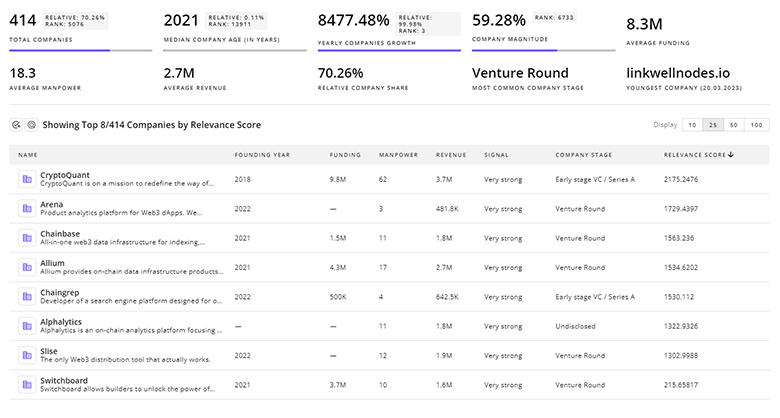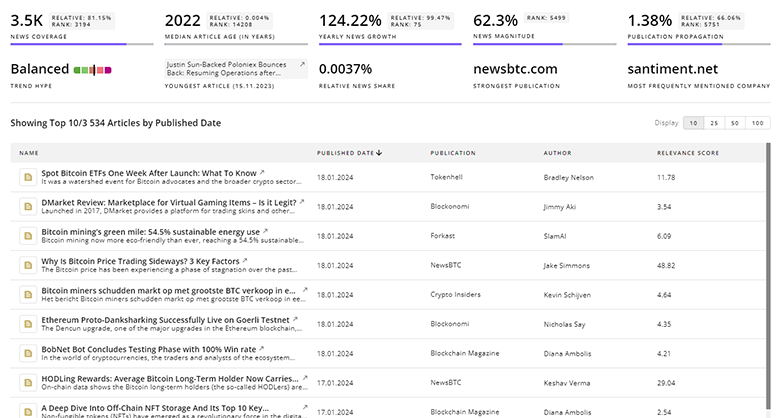
Laser Report
: Analysis on the Market, Trends, and TechnologiesThe laser market shows sustained commercial momentum, with the internal trend data reporting a market size of USD 8.3 billion in 2024 and a 7.3% CAGR projection that targets USD 28.7 billion by 2030, driven by industrial fiber lasers, medical applications, and ultrafast systems. External market studies and recent industry coverage corroborate rapid adoption in manufacturing and medical segments and highlight fiber and ultrafast lasers as the primary growth engines Market.us.
Our latest update of this report was 21 days ago. If you found a mistake or missing information, tell us!
Topic Dominance Index of Laser
The Topic Dominance Index evaluates Laser's significance by analyzing data on the distribution of news articles that mention Laser, the timeline of newly founded companies working in this sector, and global search trends
Key Activities and Applications
- Precision material processing (cut, weld, mark, micro-machine) — lasers are now core production tools in automotive, aerospace, and electronics manufacturing; fiber lasers and high-power diode modules dominate industrial throughput gains
- Additive manufacturing and laser-assisted metal 3D printing — lasers enable fine feature control and multi-material builds used in aerospace and medical implant fabrication
- Medical and aesthetic procedures — CO2, DPSS, and diode systems support ophthalmic, dermatology, and minimally invasive surgery demand, fueling a fast-growing medical laser device market segment gminsights.
- Semiconductor/photonic manufacturing and lithography — ultrafast and short-wavelength lasers enable patterning and micro-processing required for advanced nodes and packaging.
- Remote sensing, LiDAR and measurement — laser displacement sensors, ToF and LiDAR systems expand in autonomous vehicles, surveying, and environmental monitoring Allied Market Research (Laser Sensors).
Emergent Trends and Core Insights
- Ultrafast (picosecond/femtosecond) systems move from labs into production; they lower thermal damage, enable micro-electronics and medical device yields, and are achieving meaningful unit-cost declines—this materially widens addressable markets in precision manufacturing Grand View Research.
So what: adoption of ultrafast lasers substitutes slower, thermal processes and creates premium value for producers of high-spec components (medical implants, semiconductor dies). - Fiber lasers and MOPA architectures continue to capture industrial share because they scale power efficiently and reduce operating cost; high-power fiber launches (100 kW+ demonstrations) enable large-format metal cutting and shipyard applications.
So what: manufacturers replacing CO2 in heavy industrial lines see shorter cycle times and lower energy per part, accelerating capex cycles for laser retrofit projects. - Specialized wavelengths (mid-IR, blue, short-pulse UV) and component innovations (PCSELs, QCLs) create vertical niches (gas sensing, noninvasive diagnostics, copper processing) where small, focused vendors can command premium pricing mid-IR market (Allied).
So what: product roadmaps that match wavelength to application capture margin; platform players must partner or acquire niche wavelength suppliers to offer end-to-end systems. - AI, machine vision, and closed-loop controls are being embedded into laser stations for adaptive parameters, predictive maintenance, and in-process quality control.
So what: software differentiation becomes as important as laser hardware; vendors with analytics and service offerings can shift to recurring revenue models. - Laser cleaning and other eco-efficient replacement processes win procurement decisions where regulatory or sustainability goals penalize chemical or abrasive methods Adapt Laser.
So what: environmental compliance + lower waste disposal cost accelerates laser adoption in maintenance and refurbishment use cases.
Key synthesis: industrial fiber and ultrafast lasers define the growth axis; specialized wavelengths and embedded AI define differentiation and margin capture.
Technologies and Methodologies
- Fiber-laser platforms and high-brightness amplifiers (CW and pulsed) — deliver scalable power for cutting and welding while reducing maintenance compared with gas tubes GW Laser Tech.
- Femtosecond and picosecond machining — produce "cold" ablation suitable for glass, semiconductors, and medical components; critical for microelectronics and precision medical parts manufacturing.
- Quantum Cascade Lasers (QCL) and mid-IR fiber lasers — enable spectroscopic sensing and gas monitoring, expanding environmental and process control applications.
- Diode and semiconductor laser improvements (VCSELs, PCSEL) — cost-effective, compact light sources for LiDAR, optical comms and consumer sensing platforms Market.us – laser diode report.
- Adaptive beam shaping, dynamic beam combining and advanced cooling/control electronics — enable welding of difficult alloys and higher throughput in manufacturing Civan Lasers Wavelength Electronics.
- AI + machine vision + closed-loop process control — practical deployments in marking, seam tracking and in-line inspection increase yield and reduce operator skill dependence Laser Photonics.
Laser Funding
A total of 7.2K Laser companies have received funding.
Overall, Laser companies have raised $101.7B.
Companies within the Laser domain have secured capital from 14.5K funding rounds.
The chart shows the funding trendline of Laser companies over the last 5 years
Laser Companies
- Sublime Laser
Sublime Laser operates a femtosecond machining service targeted at medical component suppliers and precision parts buyers; they emphasize heat-free machining that shortens lead times from months to days and reduces secondary processing for critical implants and micro-assemblies. Their business model targets high-value, low-volume medical and R&D customers where tolerance and surface integrity command premium pricing. - LumIR Lasers
LumIR develops mid-IR fiber lasers and components for sensing, spectroscopy and select medical tools; their product set (single-mode mid-IR fiber lasers at multi-watt power) positions them to serve gas sensing and noninvasive diagnostics where mid-IR absorption lines provide unmatched specificity. By focusing on mid-IR fibers and packaging, they address a supply gap (compact mid-IR sources) that incumbents have not fully commercialized. - Veralase
Veralase markets low-cost, portable lasers for medical research and early-stage clinical applications; their handheld platforms aim to reduce equipment cost barriers for translational R&D and point-of-care trials, enabling smaller clinics and researchers to test laser-based therapies without large capital expenditure. That affordability strategy targets fast validation cycles and customer acquisition in clinical pilot programs. - Chengdu MRJ-Laser
MRJ focuses on customized laser cleaning, marking and welding modules with integrated machine vision and controllers; they have built >30 patents and emphasize tailor-made automation integration for aerospace, rail and jewelry customers, offering rapid localization and service in export markets mrj-lasermark.com. Their value comes from system-level integration (optical, mechanical, software) and after-sales service for complex production lines. - P-Laser
P-Laser sells industrial laser cleaning systems emphasizing safety, ease-of-use and environmental benefit versus chemical or abrasive methods; their commercial wins come from refurbishment, mold cleaning and heritage conservation customers who prioritize nondestructive, low-waste processes. The company couples process engineering with field services to remove buyer friction in maintenance and asset-life extension projects.
Explore comprehensive profiles of 125.6K companies shaping the future of Laser with TrendFeedr's Companies feature.

125.6K Laser Companies
Discover Laser Companies, their Funding, Manpower, Revenues, Stages, and much more
Laser Investors
TrendFeedr’s Investors tool allows you to explore detailed investment activities and trends based on 9.7K Laser investors. This tool provides an in-depth analysis of funding rounds and market dynamics to make informed investment decisions.

9.7K Laser Investors
Discover Laser Investors, Funding Rounds, Invested Amounts, and Funding Growth
Laser News
Stay updated with TrendFeedr’s News feature, which offers you access to 91.2K Laser articles. This tool provides you with a comprehensive understanding of the historical and current trends shaping the market.

91.2K Laser News Articles
Discover Latest Laser Articles, News Magnitude, Publication Propagation, Yearly Growth, and Strongest Publications
Executive Summary
The collected data shows a two-track industry: (1) scale-oriented fiber and high-power laser platforms capture volume industrial applications and will drive the largest market pools; (2) specialized wavelength and ultrafast technologies create high-margin niches in medical devices, microfabrication and sensing. Strategic winners will combine hardware exports with software and services (AI-driven process control, predictive maintenance, and application engineering) to convert one-time equipment sales into recurring revenue. For investors and industrial buyers, priority actions are (a) assess supplier roadmaps for ultrafast and mid-IR capability, (b) require AI/closed-loop features in procurement specifications to protect yield and lifecycle cost, and (c) evaluate laser cleaning and low-waste processes where sustainability and regulatory pressure create faster payback. These moves position firms to capture the expanding addressable market while mitigating supply-chain and regulatory exposure.
We’re keen to partner with subject matter experts to enrich our coverage. Think you can help? Let us know.












